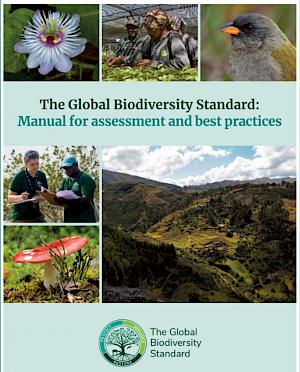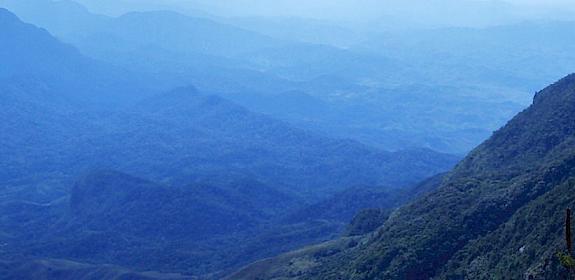New Global Biodiversity Standard Manual Will Elevate Restoration Strategies Worldwide
If managed correctly, tree planting, forest restoration, agroforestry, and other restoration initiatives can benefit biodiversity, local communities, and carbon capture at the same time according to a new set of guidelines to support effective nature restoration.
Nature-based solutions can be powerful tools for solving environmental problems, and the climate and biodiversity crises. However, many of these projects - such as tree planting - often fall short and cause harm to ecosystems and local communities.
To address this issue, Botanic Gardens Conservation International (BGCI) and a consortium of partners, including TRAFFIC, have developed The Global Biodiversity Standard (TGBS) - a site-based certification to assure that tree planting, habitat restoration and agroforestry practices are protecting, restoring, and enhancing biodiversity.
 Download
DownloadA manual full of best practices to ensure trees planted will survive and thrive for future generations of humans and wildlife has been published.
As well as direction on processes related to the TGBS, the manual includes guidance on:
- Remote Sensing Survey: Describes how to conduct remote sensing surveys for TGBS assessments, including data interpretation and analysis.
- Field Survey: Explains how to conduct field surveys for TGBS assessments, evaluating biodiversity impact, stakeholder engagement, and more.
- Assessment, Verification, and Certification: Details the TGBS assessment, verification, and certification process, including scoring sites against TGBS criteria.
- Restoration Mentoring: Outlines modules and mentoring resources for applicants, covering best practices and project sustainability.
TRAFFIC, as a technical partner, has provided expertise on sustainable resource use and trade to develop the TGBS methodology and training modules.
Restoration of fragmented and degraded landscapes is a critical biodiversity conservation strategy, integral to the achievement of the CBD’s Global Biodiversity Framework and 2030 goals. Long-term sustainability needs to consider how the restored landscapes will be used and the different stakeholder’s needs and priorities. ”
Bryony Morgan, TRAFFIC’s Project Manager for the TGBS partnership
She continues: "At TRAFFIC, we were delighted to contribute expertise on consulting and partnering with local communities, regarding the potential for sustainable harvest and trade of resources from the intervention sites.”
Sites looking to be certified by The Global Biodiversity Standard will be assessed against the following eight criteria and will need to:
- Protect existing habitats and biodiversity
- Carry out interventions in appropriate areas without displacing natural biodiversity
- Manage biodiversity in consultation and partnership with local communities and stakeholders
- Aim to maximize biodiversity recovery through restoration and natural regeneration
- Refrain from planting invasive alien species
- Use native species and incorporate threatened species in planting wherever possible
- Use plant material that is genetically diverse, appropriate, and resilient
- Implement robust monitoring, evaluation, and adaptive management of biodiversity
Dr Paul Smith, Secretary General of BGCI, the lead partner in the TGBS consortium, said “Financiers of Nature-based Solutions need assurance that biodiversity is not being damaged by the projects they support, and project practitioners need advice on how to achieve better outcomes for biodiversity and people. TGBS uniquely delivers all of this, by deploying local biodiversity expertise through a globally validated methodology.”
Turning over a new leaf
The Global Biodiversity Standard manual is the culmination of two years of rigorous testing at over 100 sites across diverse ecosystems, land uses, and countries. This extensive refinement has created a robust methodology to accurately assess biodiversity impacts, setting a new benchmark for restoration projects worldwide."
Dr David Bartholomew, joint-lead author of the TGBS manual
The Global Biodiversity Standard (TGBS) methodology outlined in this manual has been created and refined through collaboration with a diverse group of organisations and experts including SER in partnership with BGCI, the Plan Vivo Foundation, TRAFFIC, the Center for International Forestry Research, the World Agroforestry Centre (CIFOR-ICRAF), Ecosia, 1t.org and many more.

About The Global Biodiversity Standard

The GBS has been developed by Botanic Gardens Conservation International (BGCI), the Society for Ecological Restoration (SER), the Plan Vivo Foundation, TRAFFIC, Center for International Forestry Research and World Agroforestry Centre (CIFOR-ICRAF) and Ecosia.
The development of the assessment methodology has also been supported by Rabobank, Reforest’Action, the Royal Botanic Gardens, Kew, Bioflore, Space Intelligence and 1t.org.
The assessment methodology has been tested in six countries by Auroville Botanical Gardens (India), the Centre for Ecosystem Restoration – Kenya, Huarango Nature (Peru), Jardim Botânico Araribá (Brazil), Missouri Botanic Gardens Madagascar Program and Tooro Botanical Gardens (Uganda).
About the Darwin Initiative

Funded by the UK Government through the Darwin Initiative.
The Darwin Initiative is a UK government programme with a focus on biodiversity projects.




